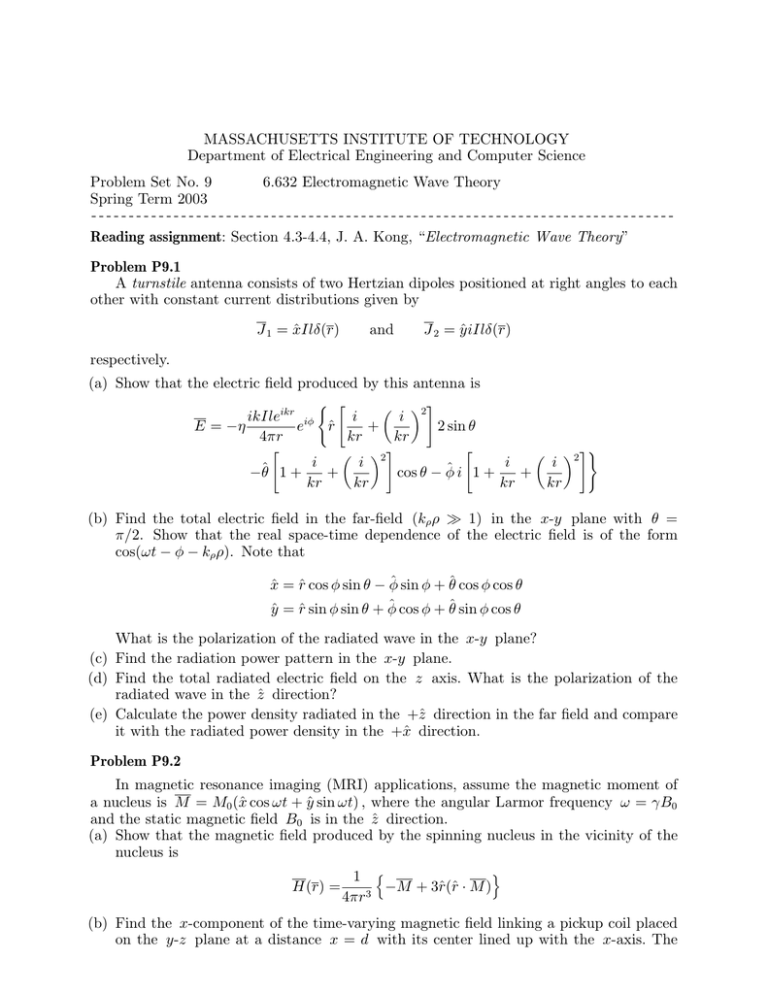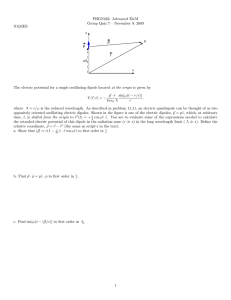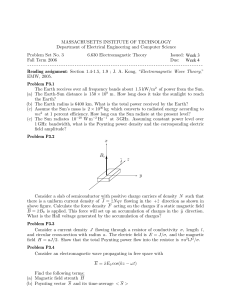MASSACHUSETTS INSTITUTE OF TECHNOLOGY Department of Electrical Engineering and Computer Science
advertisement

MASSACHUSETTS INSTITUTE OF TECHNOLOGY Department of Electrical Engineering and Computer Science Problem Set No. 9 6.632 Electromagnetic Wave Theory Spring Term 2003 -----------------------------------------------------------------------------Reading assignment: Section 4.3-4.4, J. A. Kong, “Electromagnetic Wave Theory” Problem P9.1 A turnstile antenna consists of two Hertzian dipoles positioned at right angles to each other with constant current distributions given by J 1 = xIlδ(r) ˆ and J 2 = yiIlδ(r) ˆ respectively. (a) Show that the electric field produced by this antenna is ikIleikr iφ i i E = −η e ˆr + 4πr kr kr i i −ˆθ 1 + + kr kr 2 2 2 sin θ ˆi 1+ i + i cos θ − φ kr kr 2 (b) Find the total electric field in the far-field (kρ ρ 1) in the x-y plane with θ = π/2. Show that the real space-time dependence of the electric field is of the form cos(ωt − φ − kρ ρ). Note that ˆ sin φ + ˆθ cos φ cos θ x ˆ = ˆr cos φ sin θ − φ ˆ cos φ + ˆθ sin φ cos θ ŷ = ˆr sin φ sin θ + φ What is the polarization of the radiated wave in the x-y plane? (c) Find the radiation power pattern in the x-y plane. (d) Find the total radiated electric field on the z axis. What is the polarization of the radiated wave in the ẑ direction? (e) Calculate the power density radiated in the +ˆ z direction in the far field and compare it with the radiated power density in the +x̂ direction. Problem P9.2 In magnetic resonance imaging (MRI) applications, assume the magnetic moment of x cos ωt + yˆ sin ωt) , where the angular Larmor frequency ω = γB0 a nucleus is M = M0 (ˆ and the static magnetic field B0 is in the ẑ direction. (a) Show that the magnetic field produced by the spinning nucleus in the vicinity of the nucleus is H(r) = 1 r(ˆ −M + 3ˆ r · M ) 4πr3 (b) Find the x-component of the time-varying magnetic field linking a pickup coil placed on the y-z plane at a distance x = d with its center lined up with the x-axis. The induced voltage (magnetomotive force) on the pick-up coil can be determined using the following formula ∂ V =− daBx (r, t) ∂t A Show that the induced voltage on the pick-up coil has the form V = U (ω) sin ωt Find the coefficient U (ω) . Why a large static magnetic field B0 is needed to obtain large induced voltage on the pick-up coil? (c) Consider two magnetic dipoles with the same gyromagnetic ratio γ placed on the z-axis with separation δ . Assume that the two magnetic dipoles are close to the origin so that the induced voltage due to each one can be approximated by Vi = U (ωi ) sin ωi t (i = 1, 2) . Using a radio-frequency (RF) pick-up coil, the Larmor fre­ quency ωi can be measured accurately. Let ω1 − ω2 = ∆ω . Find the difference of the static magnetic field B0 acting on the two magnetic dipole moments in terms of ∆ω and γ . (d) Let the static magnetic field be B 0 = ẑ(b0 + b1 z) and the difference of the Larmor frequencies be ω1 − ω2 = ∆ω . Find the separation δ of the two magnetic dipole moments in terms of ∆ω , γ , and b1 . (e) Assume that the magnetic dipoles are spinning protons of water at room temperature, and the gyromagnetic ratio of proton is γ = 2.7 × 108 T−1 s−1 . Let the two protons locate on the z-axis. The applied static magnetic field is B = ẑ(b0 + b1 z) , where b0 = 1.0 T and b1 = 1.0 T/m . Find the frequency resolution in kHz of the pick-up coil to measure the two protons with separation δ = 0.5 mm on the z-axis. Problem P9.3 Two short dipoles, separated by a distance d = λ/4 , are positioned at right angles as shown in Figure 9.3. Dipole 1, located at y = d/2 , is oriented in the ẑ direction and has the dipole moment I0 " . Dipole 2, located at y = −d/2 , is oriented in the x̂ direction and has the dipole moment I0 ". z y I0 " y = d/2 I0 " d = λ/4 x y = −d/2 Fig. 9.3 (a) Calculate the electric field vector E in the far field on the +y axis (θ = π/2, φ = π/2) . Describe the polarization of E , sketch the polarization ellipse, and indicate the sense of rotation of E(t) in time at a fixed point. (b) Repeat (a) for the electric field E in the farfield on the +x axis (θ = π/2, φ = 0) . (c) Calculate the time-average Poynting vector S(r, θ, φ) in the far field. (d) Calculate the total time-average power radiated from the two dipole system in terms of the radiation resistance Rrad of a single dipole. Note Rrad = 20(k")2 . Problem P9.4 A radio station is located on the coast, west of a city, as shown in Figure 9.5(a). The transmitting antenna tower may be modeled as a Hertzian dipole antenna of dipole moment Io " . N E Antenna tower φ Io "ei ψ Io " Io " d Ocean Coast (a) (b) 60 Io "ei ψ Io " d 300 (c) Fig. 9.5 (a) The radio station was able to erect another antenna tower. Relative to the first antenna tower, at what distance d should the second tower be placed and with what phase difference ψ ( −π < ψ ≤ π ) should it be fed, so that there is a null in the radiation pattern in the direction of the ocean and no “dead” spots in the reception area as shown in Figure 9.5(b). (b) As shown in Figure 9.5(c), consider another radio station which must serve two cities, sending most of the power over the land area and little power in the direction of the ocean (a null at φ = 180◦ ), with maximum radiation in the direction of the two cities ( φ = ±60◦ ), and no nulls, or “dead” spots, in the reception area ( |φ| ≤ 90◦ ). Determine the spacing d of these two antenna towers and the relative phase difference ψ ( −π < ψ ≤ π ) to satisfy these requirements.





